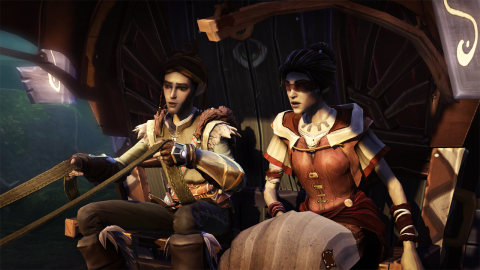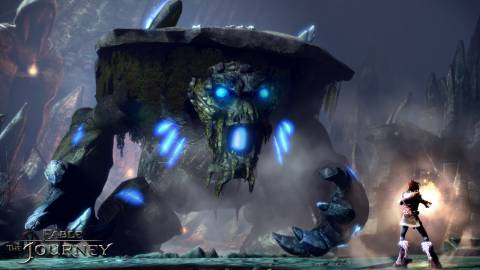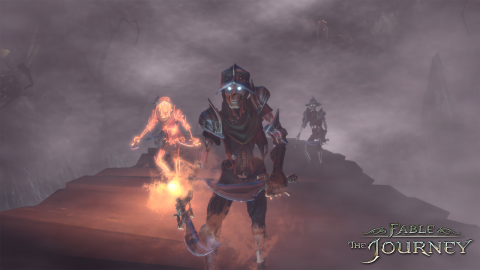
Fable: The Journey is Lionhead making the most of what it's got to work with, which in this case is the limited and unreliable range of inputs provided by Kinect. When it works, The Journey is a breezy little confection, a simple, directed romp through the fantasy lands of Albion that's shot through with Fable's special brand of charm and a healthy dose of honest-to-goodness drama. When it doesn't work, it's not much better than Steel Battalion: Heavy Armor. Good thing it works a bit more often than not.
The challenge of mushing Fable's traditionally free-wheeling role-playing style into a form suitable for Kinect's limited capabilities must have been a daunting one, and Lionhead met that challenge by...having your character walk forward automatically while you use both hands to fling magic at whatever hobbes, balverines, and hollow men come your way. Yes, contrary to what you may have heard, the game proceeds entirely on rails, but even if The Journey's action levels amount to little more than shooting galleries, there's still a bit of depth to the mixing and matching of magic within them. On your left hand, you've got a Force push of sorts that lets you stun enemies and then fling them around; on your right, you get a basic magical bolt spell that can later be morphed into an area-of-effect fireball and a powerful magic shard that can be split into multiple projectiles. You can also counter almost all enemy attacks with a quick left fist across your chest, and later levels get intense enough that you'll have to use all of these abilities pretty quickly in concert to make it through without taking too much damage.

The game does a decent job of mixing up the types of enemies it throws at you from one sequence to the next, so it's relatively rewarding to change up your spell usage, and incorporate the occasional explosive barrel or throw object, to take out foes. Plenty of later enemies also come with specific requirements, such as making you use your push spell to jerk a shield out of their hands before you can damage them. The game rewards you for dispatching enemies with style, like popping them up into the air then taking them out, or flinging them off of cliffs or into lava. So while the combat is pretty by-the-numbers and doesn't demand a lot of finesse (as long as it actually works--more on that later), you can at least get creative in the ways you deal with enemies, and you'll earn more experience points by playing with a little flair. There's a simple upgrade path that doesn't dramatically change the game, but at least lets you increase the usefulness of individual spells, make your horse stronger, or give yourself extra health.
The Journey is longer than its dozen or so self-contained action levels, though. In between those on-foot sequences--which have you exploring ancient temples, infiltrating a hobbe camp, defending a homestead from a balverine attack, and routing a stinger infestation from a deserted township, among other things--you'll view Albion from the seat of your horse-drawn cart, where you can whip your trusty mare Seren into a gallop, and take the reins to steer back and forth around obstacles and pick up some experience orbs scattered around the road. I can't say these benign travel sequences are wildly exhilarating, aside from the occasional running fight with mounted hobbes or chase sequence involving some hideous monstrosity (which are only mildly exhilarating). But they do provide a good chance for some exposition between your hero Gabriel, a rotating cast of incidental characters, and Fable's omnipresent wizened old seer Theresa about the ancient evil du jour that's threatening the land. And believe it or not, spending so much time watching the countryside roll by over my horse's hindquarters actually did go some length toward creating the illusion of a single long journey through a big, contiguous land. Know that this is a one-way trip, though, with no real meaningful choice about where you go. The path branches here and there for a couple of minutes, but that only changes the occasional sight you may see along the side of the road. Most of this journey is already written in stone. It's worth noting that Lionhead moved to the latest iteration of Unreal Engine 3 for The Journey, and as a result, what Albion there is to see here has never looked nearly this good before.

Your travels are punctuated by the occasional break to make camp, which is where the spirit of Peter Molyneux truly lives in this game. That's where you lay your magic-gauntlet-covered hands on your horse's wounds to heal them, brush her dirt off, feed her an apple, and generally take a breather. These activities don't even constitute basic minigames--they're just simple gestures--but they contribute enough to your upgrades that it's worth doing them every time they come up. More to the point, these are the sort of quiet Molyneux moments that are supposed to engender an emotional connection between you and your animal, and...they aren't completely unsuccessful at doing that. Maybe I'm a big softy, but I actually felt responsible for not messing it up every time I had to grasp an arrow embedded in my horse's rear end and very gingerly remove it without hurting her. The first time you pull too hard and she recoils in pain, you might just feel like a real jerk about it.
Then again, the only thing you can feel when the game messes it up for you is rage. The Journey is a simple and inoffensive game right up till the minute the poor reliability of Kinect suddenly makes you feel like you can't play it at all. There were several instances in combat where all of my spells were flying off in seemingly random directions and the game constantly refused to acknowledge my blocking gesture, causing me to die over and over on what should have been an extremely simple encounter, and that made me want to turn the game off and throw it out the window (as you should do with any game that refuses your best efforts to play it). For what it's worth, I never had any real trouble guiding my horse in the traveling bits, which isn't very responsive but at least worked like it should. The quality of the combat gameplay seemed overly sensitive to the lighting conditions in my living room, though, which I experimented with extensively. Once you at least get Kinect reading you consistently, there's an in-game calibration scheme that seemed to make the aiming more reliable, but an onscreen reticle indicating where your shots are actually going to land probably would have fixed all of this in the first place.
(For those interested, I've included the game's own tutorial for making Kinect behave itself.)
In light of the occasional technical problems, The Journey gets by largely on its charm, which is in abundance. There's mirth and melancholy in equal measure over the course of the storyline, which isn't especially original but is rendered effectively nonetheless. As cheeky and lighthearted as Fable is (and this installment is no exception), it says something about the game's talent for melodrama that you end up genuinely feeling sorry for certain characters on several occasions when bad things happen to them, and the game culminates in a moment that will likely be among the most poignant seen in a game this year. The whole thing is just so gosh darn British, too, which I imagine is less of a selling point if you are British. That pervasive sprinkling of refined, humorous nonsense makes The Journey feel a little more like one worth taking, even when some of its nuts and bolts are less appealing.